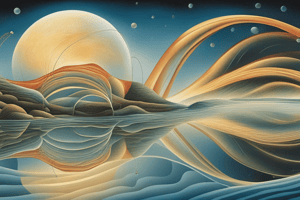Podcast
Questions and Answers
What is the fundamental force of nature that causes objects with mass to attract each other?
What is the fundamental force of nature that causes objects with mass to attract each other?
- Friction
- Electromagnetism
- Momentum
- Gravitation (correct)
Who first described the concept of gravitation in his groundbreaking work?
Who first described the concept of gravitation in his groundbreaking work?
- Galileo Galilei
- Albert Einstein
- Sir Isaac Newton (correct)
- Marie Curie
What is the mathematical representation of Newton's Law of Universal Gravitation?
What is the mathematical representation of Newton's Law of Universal Gravitation?
- F = G - (m1 - m2) / r^2
- F = G * (m1 * m2) / r^2 (correct)
- F = m1 - m2 / r^2
- F = m1 + m2 / r^2
What is the force exerted on an object by gravity, dependent on both mass and gravitational field strength?
What is the force exerted on an object by gravity, dependent on both mass and gravitational field strength?
What type of gravity holds galaxies together and governs their rotation curves?
What type of gravity holds galaxies together and governs their rotation curves?
What is the limitation of Newton's Law of Universal Gravitation at very high speeds or in extremely strong gravitational fields?
What is the limitation of Newton's Law of Universal Gravitation at very high speeds or in extremely strong gravitational fields?
What is the revolutionary theory that gravity is the curvature of spacetime caused by massive objects?
What is the revolutionary theory that gravity is the curvature of spacetime caused by massive objects?
What are the ripples in spacetime predicted by General Relativity, detected directly for the first time in 2015?
What are the ripples in spacetime predicted by General Relativity, detected directly for the first time in 2015?
Flashcards are hidden until you start studying
Study Notes
Definition and History
- Gravitation is a fundamental force of nature that causes objects with mass to attract each other.
- First described by Sir Isaac Newton in his groundbreaking work "Philosophiæ Naturalis Principia Mathematica" (1687).
- Newton's Law of Universal Gravitation states that every point mass attracts every other point mass by a force acting along the line intersecting both points.
Newton's Law of Universal Gravitation
- Mathematical representation: F = G * (m1 * m2) / r^2
- F: gravitational force between two objects
- G: gravitational constant (6.67408e-11 N*m^2/kg^2)
- m1 and m2: masses of the two objects
- r: distance between the centers of the two objects
Key Concepts
- Gravity: the force of attraction between two objects due to their mass.
- Gravitational field: the region around a massive object where the gravitational force can be detected.
- Weight: the force exerted on an object by gravity, dependent on both mass and gravitational field strength.
Gravity in the Universe
- Galactic gravity: holds galaxies together and governs their rotation curves.
- Cosmological gravity: plays a crucial role in the large-scale structure of the universe and the expansion of the cosmos.
Limitations of Newton's Law
- Fails to accurately predict phenomena at very high speeds or in extremely strong gravitational fields.
- Does not account for the bending of light around massive objects.
Modern Understanding of Gravitation
- General Relativity (1915): Albert Einstein's revolutionary theory that gravity is the curvature of spacetime caused by massive objects.
- Gravitational waves: ripples in spacetime predicted by General Relativity, detected directly for the first time in 2015.
Definition and History
- Gravitation is a fundamental force of nature that causes objects with mass to attract each other.
- Sir Isaac Newton first described gravitation in his work "Philosophiæ Naturalis Principia Mathematica" in 1687.
Newton's Law of Universal Gravitation
- States that every point mass attracts every other point mass by a force acting along the line intersecting both points.
- Mathematical representation: F = G * (m1 * m2) / r^2
- G: gravitational constant (6.67408e-11 N*m^2/kg^2)
Key Concepts
- Gravity: the force of attraction between two objects due to their mass.
- Gravitational field: the region around a massive object where the gravitational force can be detected.
- Weight: the force exerted on an object by gravity, dependent on both mass and gravitational field strength.
Gravity in the Universe
- Galactic gravity: holds galaxies together and governs their rotation curves.
- Cosmological gravity: plays a crucial role in the large-scale structure of the universe and the expansion of the cosmos.
Limitations of Newton's Law
- Fails to accurately predict phenomena at very high speeds or in extremely strong gravitational fields.
- Does not account for the bending of light around massive objects.
Modern Understanding of Gravitation
- General Relativity (1915): Albert Einstein's revolutionary theory that gravity is the curvature of spacetime caused by massive objects.
- Gravitational waves: ripples in spacetime predicted by General Relativity, detected directly for the first time in 2015.
Studying That Suits You
Use AI to generate personalized quizzes and flashcards to suit your learning preferences.




